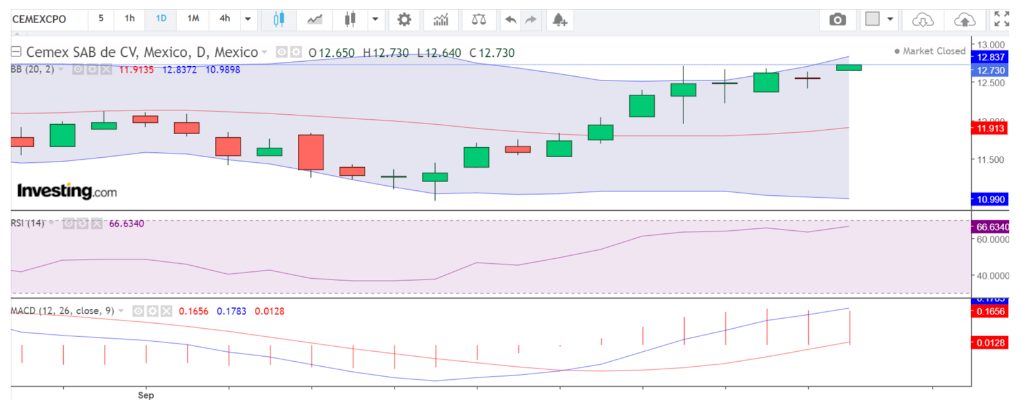CFD Trading in Mexico



Contracts for difference (CFDs) weren’t introduced in Mexico until the 2010s, but they are gaining traction, offering a flexible vehicle for capitalizing on rising and falling markets with a modest investment.
With the accessibility of online platforms like MetaTrader 4 and MetaTrader 5, and increasingly smartphone trading apps, CFDs are reshaping how Mexican investors approach Latin American and global financial markets.
Looking to start CFD trading in Mexico? This guide for beginners will arm you with the essentials.
Quick Introduction
- A CFD is a derivative that mirrors the price movement of an asset, like Mexico’s IPC 35 index. You’re speculating on whether its price will rise or fall. When you open and close the contract, the difference between the asset’s price determines your profit or loss.
- CFDs allow you to trade with leverage, meaning you can control large positions with a small investment. This multiplies profits, but also losses, so risk management through stop-loss orders and careful position sizing is essential.
- CFD trading in Mexico is supervised by the Comisión Nacional Bancaria y de Valores (CNBV), but there are limited rules specifically aimed at CFDs beyond risk disclosures.
Best CFD Brokers in Mexico
Through hands-on assessments, we've identified these 4 platforms as superior for CFD traders in Mexico:
How Does CFD Trading Work?
CFDs provide an opportunity to trade financial markets without having to own the actual asset. Instead, you are making a prediction about whether the price of an asset will increase or decrease.
One of the most appealing aspects is the use of leverage. This allows you to open large positions while only committing a fraction of the total value, known as the margin.
Imagine you believe that the Mexican Stock Exchange Index (IPC) will experience an upward trend. You can enter a CFD buy position on this index.
Suppose each contract is valued at MXN 20,000, and your brokerage requires a 5% margin. To take a position on 10 contracts, your margin requirement would be MXN 10,000 (MXN 20,000 per contract x 10 contracts x 5%).
Now, if the IPC rises to MXN 21,000, the price increase would yield MXN 1,000 per contract. By closing your position, you would realize a total profit of MXN 10,000 (10 contracts x MXN 1,000), excluding any fees charged by your broker.
Conversely, if the index falls to MXN 19,000, you would face a loss of MXN 10,000, which highlights the inherent risks associated with CFD trading.
It is essential to grasp the margin requirements and the potential risks before you start CFD trading.For those new to this type of trading, a demo trading account can be an effective way to practice strategies and build confidence before risking real capital.
What Can I Trade?
In Mexico, CFDs offer a diverse array of opportunities across various financial markets, both at home and abroad:
- Stock CFDs – Speculate on individual Mexican company stocks such as América Móvil, Cemex, and Grupo Bimbo. This enables you to engage in the performance of these leading firms without the need to purchase the actual shares.
- Index CFDs – The IPC (Índice de Precios y Cotizaciones) serves as the benchmark for the Mexican stock market, covering the top 35 companies listed on the Bolsa Mexicana de Valores (BMV). Traders often opt for IPC CFDs to capitalize on the overall performance of the Mexican market. Additionally, you could explore CFDs on major global indices like the Dow Jones or the NASDAQ.
- Forex CFDs – The Mexican peso (MXN) is actively traded in the foreign exchange market. You can speculate on popular currency pairs, including USD/MXN and EUR/MXN. These pairs provide liquidity and opportunities for short-term traders.
- Commodity CFDs – Access essential commodities such as gold, silver, and crude oil. This allows you to speculate on the price movements of these vital resources that significantly impact the global economy.
- Crypto CFDs – The rise of digital assets has not gone unnoticed in Mexico. Traders have the option to engage in CFDs on cryptocurrencies like Bitcoin and Ethereum, giving them access to the highly volatile and high-risk world of crypto.
Is CFD Trading Legal In Mexico?
CFD trading is legal in Mexico. The financial sector in Mexico is overseen by the Comisión Nacional Bancaria y de Valores (CNBV), the national banking and securities commission.
While CFDs are a legitimate form of trading, they are considered high-risk financial products, and Mexican authorities, like regulators in many other countries, advise caution.
While CFD trading is legal, few local Mexican brokers offer this service. Many Mexican traders use international firms regulated by authorities like the FCA in the UK or CySEC in Cyprus, both ‘green tier’ bodies in DayTrading.com’s Regulation & Trust Rating.
Brokers operating in Mexico or offering services to Mexican residents must comply with Know Your Customer (KYC) and Anti Money Laundering (AML) laws.This means you will likely need to provide identification, such as a copy of your Voter ID Card (Credencial para Votar), to open a CFD trading account.
Is CFD Trading Taxed In Mexico?
CFD trading is taxed in Mexico and it’s vital you comply with local tax regulations and report your earnings to the Mexico Tax Administration Service.
Profits from CFD trading are generally considered capital gains, with the tax rate varying depending on your overall income and tax bracket but typically ranges from 15% to 35%.
Mexican tax law allows traders to offset losses against gains. If you have a losing trade, you may be able to reduce your taxable income by reporting the loss, potentially lowering your overall tax liability.
Maintain accurate records of all your trades, including profits, losses, and fees, as these are essential for calculating your capital gains and losses for tax purposes.
You are required to report your CFD profits when filing your annual tax return. While some foreign brokers might withhold tax on profits, it is still your responsibility to declare those profits in Mexico.
Example Trade
Let’s walk through a detailed CFD trade in Mexico to show you how it works in practice.
Background
The Mexican Stock Exchange (Bolsa Mexicana de Valores), commonly known as Mexican Bolsa, Mexbol, or BMV, is one of two stock exchanges in Mexico. The other is BIVA (Bolsa Institucional de Valores).
Some of the most popular shares traded on Mexico’s exchanges are available as CFDs through accredited trading platforms.
I took a long CFD trade position in CEMEX (CEMEX, S.A.B. de C.V.), a company listed on the Mexico Stock Exchange. It produces, markets, distributes, and sells cement, ready-mix concrete, aggregates, and other construction materials and services worldwide.
Why Did I Use CFDs?
The main advantages of CFDs are the ability to go long and short (buy and sell) and the fact you can trade a stock’s price movement for a fraction of the cost needed to buy and hold or to enter into arranging to short the stock through a broker. Consider the following scenario:
An investor buys one hundred shares (approximately $12,000 worth of shares) in an unleveraged trade. However, I made the same transaction in a leveraged CFD trade on CEMEX.
The unleveraged investor pays the total value of the shares, $12,000. In comparison, as a CFD trader, I chose leverage of 1:5. My margin for the trade is just one-fifth of the total exposure, $12,000. My total exposure is $12,000, and my margin is $2,400 ($12,000 ÷ 5 = $2,400). So, I put up far less capital to control the same value of shares.
Cemex Fundamentals
Before committing to a CFD share trade, you must do your homework on the company’s metrics.
Unlike forex analysis, with stock CFD picks, you don’t have to scope your economic calendar for news on inflation, GDP, unemployment, retail data, etc. However, with a firm involved in global construction, macroeconomic trends will have an impact.
CEMEX had a P/E ratio of 53.46. The 52WK range was 10.4 – 15.3, the market capitalization was $182b, and analysts’ consensus was a strong buy. I decided to go long because, in my opinion, the stock was undervalued at 12.00.
Technical Analysis
I prefer uncluttered charts and concentrate on simplicity wherever possible. For that reason, I use a maximum of three technical indicators. The purpose is to discover a reason to get in or out, to find momentum, volatility, a trend, and whether or not the stock looks oversold or overbought.
To establish those criteria, I look at the RSI (volatility, oversold/overbought), the MACD (trend and momentum), and the Bollinger Bands (entry, exit, and sentiment turn).
Rather than using traditional candlesticks, I prefer Heikin Ashi because the smoothed nature of the candles and formations delivers consistent and easily identifiable patterns for making decisions.
I never tamper with the standard settings on the indicators for two reasons.First, the creators of the indicators designed them to work on higher time frames, such as weekly and monthly and did so before online trading even existed.
Second, if you start adjusting the settings, you’ll be tempted to constantly curve-fit previous outcomes to the settings, which is a potential recipe for disaster.
Cemex D1 chart
I’m always looking for key elements on my chart that align so I can make entry and exit decisions and perhaps move my stop loss and profit limit orders.
My technical analysis revealed the following key points:
- The MACD moving averages had crossed, and the MACD histogram was positive, indicating a change in trend and momentum from bearish to bullish.
- The RSI rose above the 50 median level, indicating bullish volatility but short of the 70 oversold reading.
- The BBs began to expand. During the previous downward trend, the wick of the HA daily candle pierced the lower band.

The HA bars/candlestick formation suggested the downtrend was ending; a candle with upper and lower shadows (wicks) followed the Doji. Next, we see a closed candle with a small upper shadow, suggesting the change in sentiment was gaining strength.
Despite the next candle indicating a ranging market, the following day’s candle was again bullish, encouraging me to take the long trade with a market order at 12.00.
Risk Management
I tend to place stop-loss orders where I’m convinced the trade will have gone wrong. So, I’ll pick the recent high or low, depending on my trade direction; in this instance, that’s 10.950, just below the recent low.
I didn’t set a take profit limit order; I decided to wait for the indicators to align so I could close the trade. I closed in profit at 12.70. I may have left potential profit on the table, but the return on this trade was enough.
Bottom Line
CFD trading in Mexico is becoming attractive for a diverse range of investors due to its flexibility and global market access. However, traders must stay informed about the risks, regulations, and tax implications.
To get started, use DayTrading.com’s choice of the top CFD trading platforms.
Recommended Reading
Article Sources
- Comisión Nacional Bancaria y de Valores (CNBV)
- Mexico Tax Administration Service
- CEMEX
- Mexican Stock Exchange (Bolsa Mexicana de Valores)
- BIVA (Bolsa Institucional de Valores)
The writing and editorial team at DayTrading.com use credible sources to support their work. These include government agencies, white papers, research institutes, and engagement with industry professionals. Content is written free from bias and is fact-checked where appropriate. Learn more about why you can trust DayTrading.com



